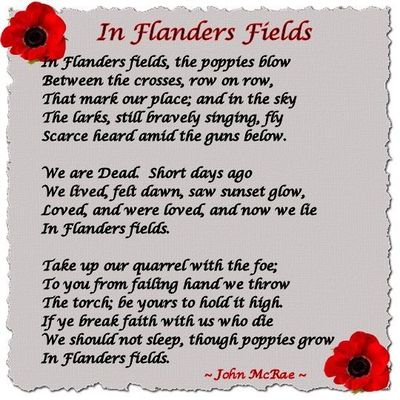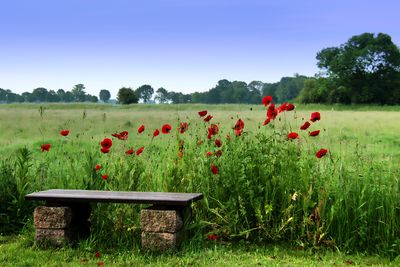In Flanders Fields
"In Flanders Fields" is a war poem in the form of a rondeau, written during the First World War by Canadian physician Lieutenant-Colonel John McCrae. He was inspired to write it on May 3, 1915, after presiding over the funeral of friend and fellow soldier Lieutenant Alexis Helmer, who died in the Second Battle of Ypres. According to legend, fellow soldiers retrieved the poem after McCrae, initially dissatisfied with his work, discarded it. "In Flanders Fields" was first published on December 8 of that year in the London magazine Punch. Flanders Fields is a common English name of the World War I battlefields in Belgium and France.
It is one of the most quoted poems from the war. As a result of its immediate popularity, parts of the poem were used in efforts and appeals to recruit soldiers and raise money selling war bonds. Its references to the red poppies that grew over the graves of fallen soldiers resulted in the remembrance poppy becoming one of the world's most recognized memorial symbols for soldiers who have died in the conflict. The poem and poppy are prominent Remembrance Day symbols throughout the Commonwealth of Nations, particularly in Canada, where "In Flanders Fields" is one of the nation's best-known literary works. The poem is also widely known in the United States, where it is associated with Veterans Day and Memorial Day.
Background
Lieutenant Colonel John McCrae was a soldier, physician and a poet and physician from Guelph, Ontario. He developed an interest in poetry at a young age and wrote throughout his life. His earliest works were published in the mid-1890s in Canadian magazines and newspapers. McCrae's poetry often focused on death and the peace that followed.
At the age of 41, McCrae enrolled with the Canadian Expeditionary Force following the outbreak of the First World War. He had the option of joining the medical corps because of his training and age but he volunteered instead to join a fighting unit as a gunner and medical officer. It was his second tour of duty in the Canadian military; he had previously fought with a volunteer force in the Second Boer War. He considered himself a soldier first; his father was a military leader in Guelph, and McCrae grew up believing in the duty of fighting for his country and empire.
McCrae fought in the Second Battle of Ypres in the Flanders region of Belgium, where the German army launched one of the first chemical attacks in the history of war. They attacked French positions north of the Canadians with chlorine gas on April 22, 1915, but were unable to break through the Canadian line, which held for over two weeks. In a letter written to his mother, McCrae described the battle as a "nightmare,"
- For seventeen days and seventeen nights, none of us have had our clothes off, nor our boots even, except occasionally. In all that time while I was awake, gunfire and rifle fire never ceased for sixty seconds ... And behind it all was the constant background of the sights of the dead, the wounded, the maimed, and a terrible anxiety lest the line should give way.
- — McCrae
Alexis Helmer, a close friend, was killed during the battle on May 2. McCrae performed the burial service himself, where he noticed how poppies quickly grew around the graves of those who died at Ypres. The next day, he composed the poem while sitting in the back of an ambulance at an Advanced Dressing Station outside Ypres. This place has since become known as the John McCrae Memorial Site.
Remembrance poppies
The red poppies that McCrae referred to had been associated with conflict since the Napoleonic Wars when a writer of that time first noted how the poppies grew over the graves of soldiers. The damage done to the landscape in Flanders during the battle greatly increased the lime content in the surface soil, leaving the poppy as one of the few plants able to grow in the region.
Inspired by "In Flanders Fields", American professor Moina Michael resolved at the war's conclusion in 1918 to wear a red poppy year-round to honour the soldiers who had died in the war. She also wrote a poem in response called "We Shall Keep the Faith". She distributed silk poppies to her peers and campaigned to have them adopted as an official symbol of remembrance by the American Legion. Madame E. Guérin attended the 1920 convention where the Legion supported Michael's proposal and was inspired to sell poppies in her native France to raise money for the war's orphans. In 1921, Guérin sent poppy sellers to London ahead of Armistice Day, attracting the attention of Field Marshal Douglas Haig. A co-founder of The Royal British Legion, Haig supported and encouraged the sale. The practice quickly spread throughout the British Empire. The wearing of poppies in the days leading up to Remembrance Day remains popular in many areas of the Commonwealth of Nations, particularly Great Britain, Canada and South Africa and in the days leading up to ANZAC Day in Australia and New Zealand.
Chat rooms • What links here • Copyright info • Contact information • Category:Root

